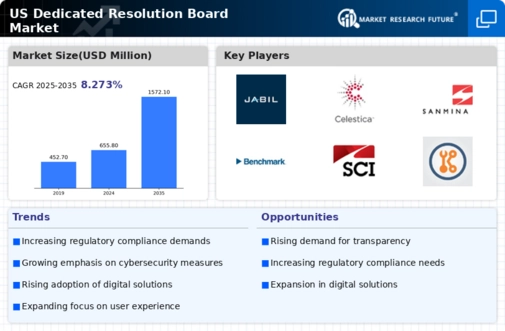Integration of Smart Technologies
The integration of smart technologies into the dedicated resolution-board market is transforming how displays are utilized in various applications. Smart boards equipped with interactive features, such as touch sensitivity and connectivity options, are becoming increasingly popular in educational institutions and corporate environments. This shift is indicative of a broader trend towards digitization and interactivity, which enhances user engagement and collaboration. The market for smart displays is expected to reach $5 billion by 2026, reflecting a growing preference for innovative solutions. As a result, the dedicated resolution-board market is likely to see a rise in demand for products that incorporate these advanced features, catering to the needs of tech-savvy consumers.
Emphasis on User Experience and Aesthetics
The dedicated resolution-board market is increasingly influenced by the emphasis on user experience and aesthetics in product design. Consumers are not only looking for functionality but also for visually appealing displays that enhance their environments. This trend is particularly evident in sectors such as retail and hospitality, where the presentation of information plays a crucial role in customer engagement. Manufacturers are responding by developing resolution boards that combine high performance with sleek designs, thereby appealing to a broader audience. As a result, the dedicated resolution-board market is likely to experience growth driven by the demand for aesthetically pleasing and user-friendly products, potentially leading to a market expansion of 6% in the coming years.
Rising Demand for High-Resolution Displays
The dedicated resolution-board market experiences a notable surge in demand for high-resolution displays across various sectors, including healthcare, education, and entertainment. As consumers increasingly seek enhanced visual experiences, the market is projected to grow at a CAGR of approximately 8% over the next five years. This growth is driven by advancements in display technologies, such as OLED and 4K resolution, which offer superior image quality. Furthermore, industries like telemedicine and remote learning are adopting high-resolution displays to improve communication and information sharing. Consequently, the dedicated resolution-board market is likely to benefit from this trend, as manufacturers strive to meet the evolving needs of consumers and businesses alike.
Growing Focus on Remote Collaboration Tools
The rise of remote work and collaboration has led to an increased focus on tools that facilitate effective communication and teamwork. The dedicated resolution-board market is witnessing a shift towards products that support remote collaboration, such as interactive displays that allow multiple users to connect and share information seamlessly. This trend is particularly relevant in corporate settings, where teams are increasingly distributed across various locations. As organizations invest in technology that enhances remote collaboration, the dedicated resolution-board market is likely to see a corresponding increase in demand for innovative solutions that cater to this need. Market analysts project a growth rate of around 7% in this segment over the next few years.
Increased Investment in Digital Infrastructure
The dedicated resolution-board market is poised to benefit from increased investment in digital infrastructure across the United States. Government initiatives aimed at enhancing technological capabilities in various sectors, including education and healthcare, are driving this trend. For instance, the U.S. government has allocated substantial funding to improve digital resources in schools, which includes the procurement of high-quality resolution boards. This investment is expected to create a favorable environment for the dedicated resolution-board market, as educational institutions seek to upgrade their facilities with state-of-the-art technology. The anticipated growth in this sector could lead to a market expansion of approximately 10% over the next few years.

















Leave a Comment